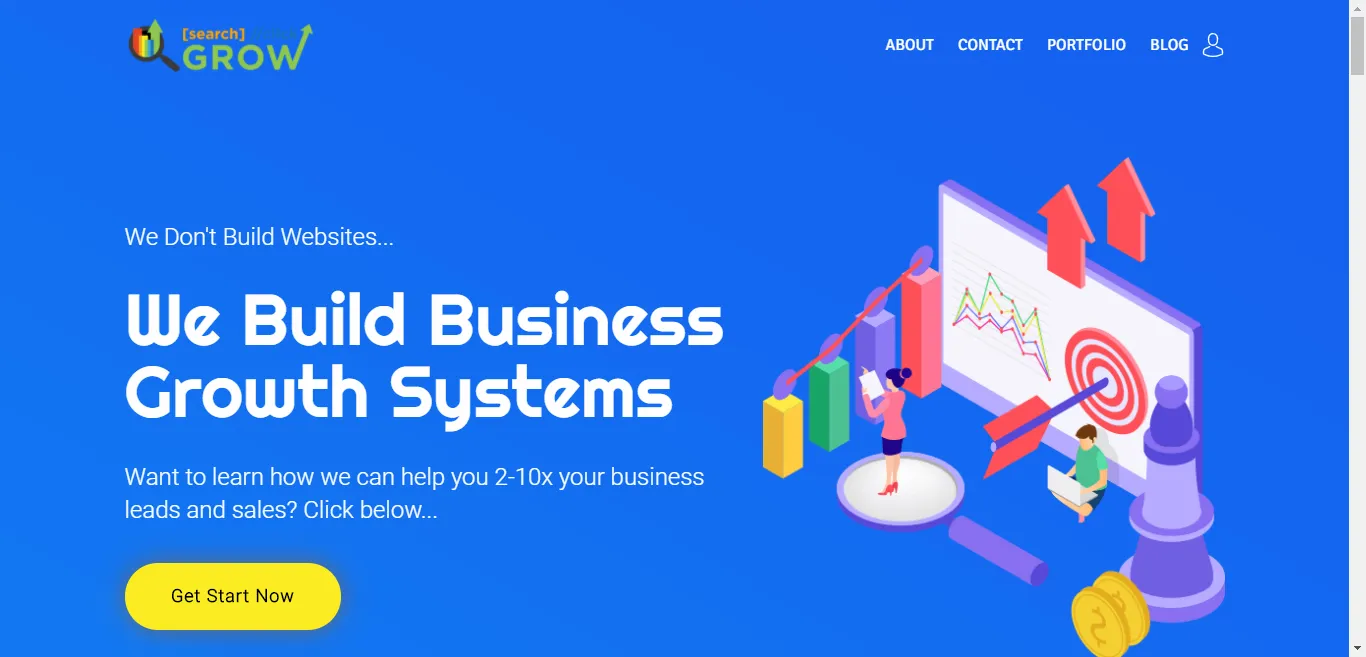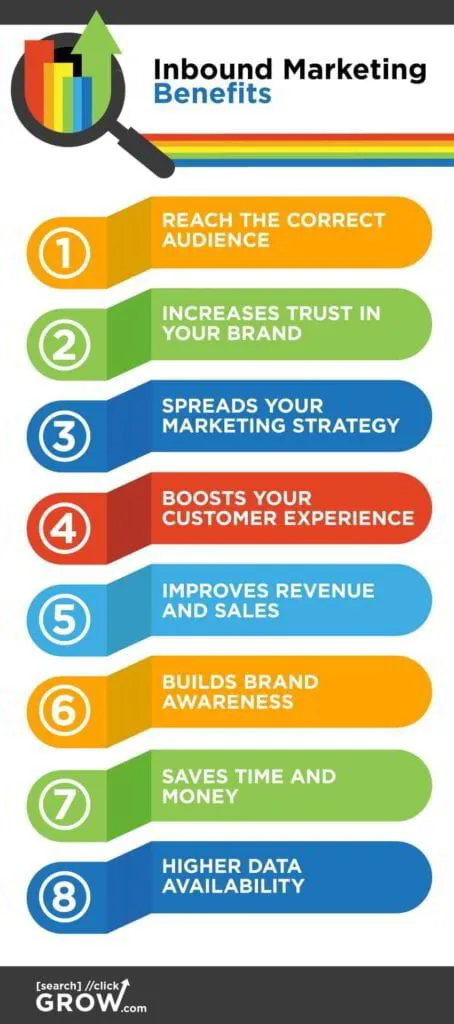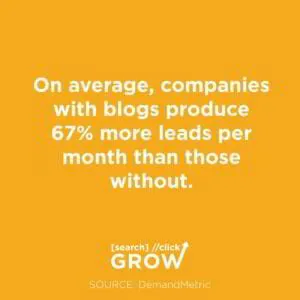No one likes to watch their favorite TV shows and have commercials pop upright in the middle, or finding their inbox full of sales emails from companies they never heard of or subscribed to.
These are mass marketing techniques, and they’re not effective anymore. Today, customers decide who to buy from, which products interest them, and whether they want to see advertisements or not.
For these reasons, brands are starting to embrace an inbound marketing strategy.
But what is inbound marketing?
This is a business technique that will draw customers in instead of sticking unsolicited content and promotions in their faces.
Inbound marketing is something you want to embrace if you don’t want to alienate your customer base.
Here’s an outline of everything we will cover so you can decide if this is a viable option for you to pursue in your business:
- What is inbound marketing?
- Inbound marketing vs outbound marketing
- Inbound marketing strategies
- Why use inbound marketing
- Benefits of inbound marketing
- Inbound Marketing examples
What is Inbound Marketing?
Before diving into how you use inbound marketing, you have to have a good understanding of what it is.
The goal of inbound marketing is to draw potential customers to your brand or products.
You do this instead of the traditional way of marketing that pushes services, products, or a brand onto people with the hope they will see it and generate a lead or buy it.
For digital marketing purposes, inbound marketing uses a mix of marketing media and channels. Commonly called content marketing; it uses elements of search engine optimization, and social media in creative ways that draw people to it.
If your inbound marketing strategy is effective, you should see an increase in the quality of your traffic, a broader reach, and more conversions and engagement.
Your buyers are more empowered today than ever before, and the internet gives them instant gratification. They can access pricing, detailed specifications, and reviews with a few clicks any time of the day or night.
The social platforms encourage you to compare and share what you find, and mobile devices allow you to carry the internet with you.
Inbound marketing gives you the answers you’re after right when you need it. This helps to build your reputation as a business and trusted authority.
In turn, your customers and potential customers trust your brand, products, or services and are less hesitant to buy from you.
It’s hard to compete with this, which is why traditional marketing tactics like shoving your products or services in the customers’ faces are being used less and less.
Inbound Marketing vs Outbound Marketing
If you’re struggling to find the difference between inbound vs outbound marketing, take a look at their names. With inbound marketing, you’re trying to draw your potential customers in.
On the other hand, outbound marketing is pushing your brand, services, or products outward. When you use inbound marketing, you’re trying to earn attention.
Outbound marketing means you buy attention from your customers.
Paid Marketing – Outbound Marketing
When you think of paid media, you most likely think of outbound marketing. Paid media encompasses emails, display advertising, PPC, and traditional offline advertising techniques.
It covers advertising on social platforms like promoted posts on Twitter or Facebook advertising.
Although it has strong ties to outbound marketing, social paid advertising is a very effective way to increase your inbound marketing campaign. For example, consider advertising on Facebook.
This advertising technique allows you to promote your campaign and content at a specifically tailored audience, and it doesn’t matter which niche you want to target.
Earned and Owned Media – Inbound Marketing
When you perform an inbound marketing campaign, you’re using earned and owned media in creative ways to engage your potential customer base.
Earned Media
This is the coverage you get as the direct result of your hard work on your marketing campaign. If you think about offline earned media, it involves coverage in magazines and newspapers.
For online earned media, you’re talking about getting campaign hashtags, online reviews, mentions on social platforms, and coverage on news sites by using a digital PR campaign.
With earned media, you have very little control over how much you get. You should see it as a direct reward for a successful inbound marketing campaign.
Owned Media
On the other end of the spectrum, you have owned media, which is exactly what it sounds like. If you own the media, your business or brand has direct control over it.
This includes things like your social media profiles, blog posts, webinars, websites, YouTube channels, and product or service landing pages.
It’s owned media because you directly control what you want to publish when you publish it, and how you publish it.
Inbound Marketing Strategies
The following strategies for inbound marketing can help you effectively market your brand, services, or products to your targeted audience.
You want to attract, engage, and delight your customers to help build their loyalty to your brand.
Attracting Your Customers
Content development and creation have direct ties to using inbound marketing techniques to attract customers and potential customers.
To start, create content and publish it. This could be things like blog articles, social posts, and content offers. They provide value for whoever sees it.
You could have a guide on how to use specific products, testimonials, information about how your services can solve your customer’s problems, or discount or promotion information.
Have an SEO strategy in place to optimize your strategy. This will help you create deeper connections with your audience. This strategy will mean that you target specific sets of keywords or key phrases directly related to your services and products.
They should also include your customer’s problems you solve and the ways your services or products help your target audience.
Doing this will allow your information and content to appear high in the search engine results page when people do organic searches for this specific information. In turn, this attracts more targeted audiences to your pages.
Engaging Your Customers
Inbound marketing is a great way to engage your customers. However, you do want to make sure that you’re dealing and communicating with potential customers and leads in a way that encourages them to trust your brand and build a long-term relationship.
When you engage your customers, tell them about your business’s value and how your products or services provide it.
For specifics, it could include how you manage and handle any inbound sales calls you get. You want to put a hard focus on how your customer service representatives talk to the people on the other end of the phone.
Additionally, focus on selling a solution rather than a service or product. This means your deals will turn into a mutually beneficial agreement for your business and the customer.
Delighting Your Customers
When you inject delight into your marketing strategies, you’re working to make sure all of your customers are supported, satisfied, and happy.
To do this, you can incorporate chatbots or surveys to support, assist, and request that your customer give you feedback about their experience. Throughout the customer’s journey, inject surveys and bots to ensure they bring value to your customer.
You can have your chatbot help your current customers incorporate a new tactic or technique you recently started offering. You can send out a satisfaction survey six months after your customers bought a service or product to get their feedback.
This will help you improve it. Listening to the various social platforms allows you to connect with your customers. They can provide feedback, share their experiences, and ask questions. Respond by making sure your information supports, encourages, and helps your followers.
Why Use Inbound Marketing
It’s simple. You want to use inbound marketing to guide your buyers along every step of the buying journey.
By incorporating useful content every step of the buying journey for your customers, you can encourage them to talk about their experience and visit your website. This brings them into your sales funnel.
Your team can take over at this point and answer any questions or share information that guides the customers to specific products.
You can also use inbound marketing tactics to increase your brand’s visibility and reach.
You’re targeting a specific audience, but this audience can share your products or services to more people.
In turn, you gain more customers without having to do anything extra.
Benefits of Inbound Marketing
There are many benefits of inbound marketing, which is why it’s so popular with large and small brands around the world.
We picked out the biggest ones for you below.
Reach the Correct Audience
The goal of this marketing strategy is to attract a very targeted audience that will buy your products or services.
Inbound marketing allows you to find the correct audiences in the correct places and attract a host of target customers at once.
This is a huge improvement in spending money and reaching the wrong audience that isn't interested in your brand, products, or services.
Increases Trust in Your Brand
This marketing strategy revolves around giving your potential customers the information they need right when they need it. The trick is to do it engagingly.
This strategy isn’t about shoving sales in peoples’ faces at every chance you get. Instead, you use this marketing strategy to present your products, services, or brand as a reliable and useful resource.
In turn, the customers will come to you when they want to make a purchase.
Spreads Your Marketing Strategy Over Multiple Channels
You don’t want to rely on one marketing channel for your business. The goal is to pursue high-quality traffic from several different sources, including social platform referrals, organic search, and mentions from website referrals.
You reduce your risk of heavily relying on a single marketing channel.
Boosts Your Customer Experience
Your customers are central to your business, and this marketing strategy boosts their overall experience. Since you tailor your sales funnel to providing solutions to their problems, it takes an individualized approach that they’ll appreciate.
In turn, this helps you nurture a strong relationship, so they come back to your business time and time again.
Improves Revenue and Sales
Getting tailored leads into your sales funnel is extremely important, and using this strategy is the way to do it.
You get a more precisely targeted audience, which helps ensure you don't waste your marketing money on people who won't buy your products or services or invest in your brand.
Builds Brand Awareness
The more people who know about your brand, the better your chances are of getting your products and services sold and out the door.
Since you tailor this marketing strategy to interested people and create a thoughtful customer journey, they're more likely to share their experience.
They'll tell their friends and family, and it'll ripple out. When it does, you get a greater brand awareness without having to do anything extra.
Saves Time and Money
You don’t want to waste marketing money on people who are not going to buy your products or use your services.
With this type of marketing, you won’t have to worry about that.
Instead, it will save you both time and money. You know your target and interested audiences, and you market directly to them.
You won’t spend time trying to market to a huge range of people, and you’ll see a higher return to save you money.
Higher Data Availability
You need data to prove to you that your marketing strategy is working well. This type of marketing strategy gives you a higher amount of data to work with.
Analytics can show you the best possible leads to follow that are more likely to result in sales, and you can track these analytics throughout your marketing campaign.
Inbound Marketing Examples
Are you wondering what types of inbound marketing you can incorporate into your business?
There are several great examples available, and we picked out a few to help inspire you.
- Content Hubs – Content hubs are excellent ways to bring a lot of customers and potential customers to your business. You can include a host of information like blogs, webinars, how-to video guides, white papers, and case studies all in one centralized location.
- Content Your Customers Generated – Your users will generate content after they interact with your company or use your products or services. This includes things like a review compilation, photography competitions, and participation in a marketing campaign on a social platform. You can showcase all of this to build trust in your next campaign.
- Quality Content – Your users like the content they can learn from and relate to, so generating quality content should be at the top of your list. Get a company blog and write several different long and short-form posts. Make sure you add to it consistently and update it as needed.
- Interactive Pieces – Since it’s the digital age, people like things they can interact with. If you have any business partnerships, use them to create these interactive pieces. Once you have them, you can launch a PR campaign to improve both of the business’s reputations and draw more people.
- Adding Search Engine Optimization into Your Content – If you haven’t incorporated these strategies and techniques into your website, now is the time. Use both long and short-tail keywords and phrases to enhance your content and increase the search engine rankings.
Wrapping It Up
Now you know what an inbound marketing technique is, the difference between inbound and outbound marketing, why use it, benefits, examples, and more.
You can now apply this knowledge to your own business to help bring in more organic traffic, generate more sales, and revenue.
If you’d like help creating and executing an inbound marketing strategy, schedule a chat with our Chief Growth Officer, Micha McLain.










